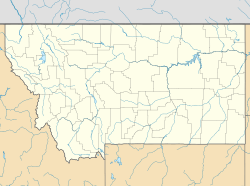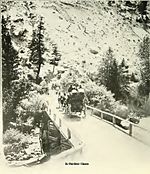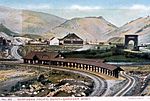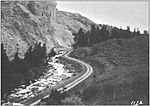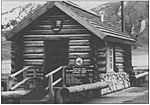North Entrance Road Historic District facts for kids
Quick facts for kids |
|
|
North Entrance Road Historic District
|
|
 |
|
| Nearest city | Yellowstone National Park, Montana and Wyoming |
|---|---|
| Built | 1883 |
| Architect | COE |
| MPS | Yellowstone National Park MPS |
| NRHP reference No. | 02000529 and 02000530 |
| Added to NRHP | May 22, 2002 |
The North Entrance Road Historic District is a special part of Yellowstone National Park. It includes the main road that goes from Gardiner, Montana, all the way to the park's main office at Mammoth Hot Springs, Wyoming. This road is about five miles (8 km) long.
This road was the very first important road built in Yellowstone. It was needed to connect the U.S. Army station, called Fort Yellowstone, to the train station in Gardiner. The famous Roosevelt Arch is at the start of this road. The road winds through hills and crosses the Gardner River. It then connects to the park's main driving loop, the Grand Loop Road.
The road was first planned in 1883 by Lieutenant Dan Christie Kingman. He was an engineer with the U.S. Army Corps of Engineers. Later, Captain Hiram M. Chittenden improved the road. Before this road, there was an older path called the Gardiner High Road. The first building for park rangers to check cars entering the park was built in 1921. Before that, rangers used temporary tents near the Roosevelt Arch. The North Entrance Road is also part of a larger highway, US 89, but it doesn't have signs saying "US 89" on it.
Contents
A Historic Path into Yellowstone
The North Entrance Road is more than just a way to get into Yellowstone. It's a historic district, meaning it's a special area with important old buildings and features. These places help us understand the past. This road was vital for the early days of the park. It allowed visitors to easily reach the park from the train station.
Building the Road
In the late 1800s, the U.S. Army managed Yellowstone National Park. They needed a good road to connect their base, Fort Yellowstone, with the outside world. Lieutenant Dan Kingman started planning this important road in 1883. His work helped create a smooth path for wagons and, later, cars.
Captain Hiram M. Chittenden later made the road even better. He was also an Army engineer. These engineers helped shape how people explored Yellowstone. They made it easier for everyone to enjoy the park's wonders.
Key Features Along the Way
As you drive along the North Entrance Road, you'll see several interesting things. The most famous is the Roosevelt Arch. This large stone arch marks the official northern entrance to the park. It was built in 1903 and named after President Theodore Roosevelt.
The road also crosses the Gardner River. This river flows through a beautiful canyon. The path winds through rolling hills, offering great views of the landscape. It's a scenic drive that shows off the park's natural beauty.
The Entrance Station
For many years, park rangers checked visitors entering Yellowstone. At first, they used simple tents near the Roosevelt Arch. But in 1921, a permanent building was constructed. This was the first official entrance station. It made it easier for rangers to greet visitors and collect fees. Over the years, the entrance station has been updated. However, its purpose remains the same: to welcome people to Yellowstone.
- Images of the North Entrance Road Historic District
Images for kids
-
The North Entrance Road washout along the Gardner River after the 2022 floods.


